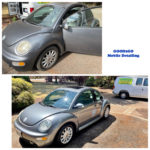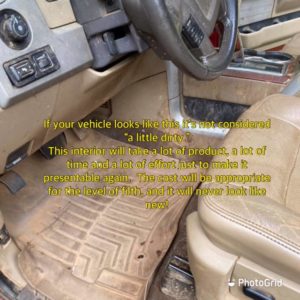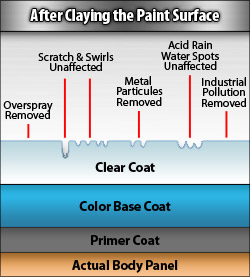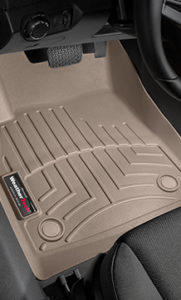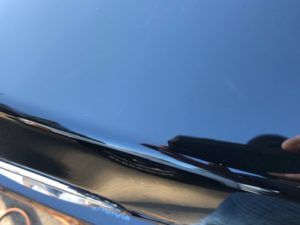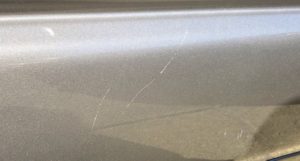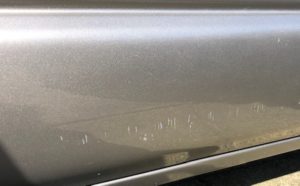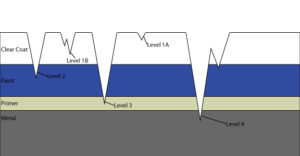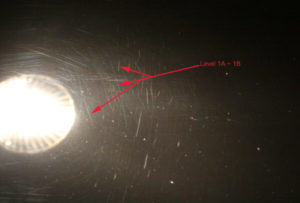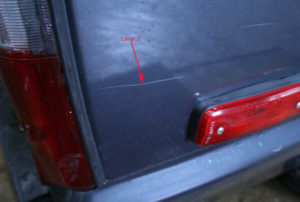Levels of Detail
The term “Full Detail” is confusing, frustrating and needs some clarity. I personally do not use the term because my definition is going to differ from another detailer, a client etc. I look at detailing a vehicle the same way I look at maintaining a vehicle (i.e. keeping it on the road). As a vehicle owner there are things I do on a routine basis that I don’t expect a dealership or local mechanic to do. These are usually minor things and I do them almost automatically now. They include keeping the tires full of the correct pressure, the wiper blades working properly, the oil and coolant levels within ranges – you get my point. The shop takes care of my clutch and brakes, the U-joints, the climate control system etc. Its the same for detailing. There are some things that should be done at least every other week (weekly is better) and can easily be done by the owner. This is what I would call Level 1 and includes basic hand washing, brake dust removal from rims, degrease tires, vacuum the interior, a fast wipe down of the dash and cup holders and apply a quick detailer spray on the paint that can even be used to aid the drying process, of course with a designated microfiber towel. The quarterly or semi-annually cleanings [Level 2] takes it to the next step and can be accomplished either by a detailer or the enthusiastic owner to ensure all the nooks and crannies are checked, cleaned and protected. This might include deep cleaning all the rubber and plastics (dash, pedals, console, grab handles, visors, gear shift, steering wheel, door sills, door jams, convertible top protection, shampooing carpets and seats, engine cleaning (if you care about that) and the list goes on. When nothing is done for Level 1 and its just detailed every 6 months or so, its going to take much longer, use more products and tools and cost significantly more. Best practices: Keep the vehicle regularly washed and spray waxed, clean up spills before they have time to set, and detail it every 3 to 6 months. Level 3 for me is the “more is better” but not really required or noticed level. This may be suited more for the show vehicles, the garage queens and Sunday drivers and includes things like: graphene or ceramic paint coatings; dressing items such as wheel arches, weather stripping, even the rubber boots of electrical connections (yes, even that); cleaning the headliner, the spare tire, all visible gaskets, nuts, bolts, fasteners etc. So, when someone says “I want a full detail,” there is reason it has to be discussed.
Why get a detail instead of just going to the car wash?
This is not knocking the tunnel wash (even one with a “premium detail option”) like most things they serve a purpose, but it’s not focused on what most would consider detailing. Aside from cost, the level of work performed, the products and tools used, the experience level and the “attention to detail” is usually going to be significantly different. You can wash and wax 3000 cars and still have no clue how to properly detail a vehicle. A detailer (mobile or shop) will take the basic “wash and vacs” to a very high level since it is the starting point for further services that may be requested e.g. sealant applications, ceramic coatings, steam cleaning or hot water carpet extractions etc. Most people don’t care about isolated defects, isolated water spots or the benefits of ceramic coatings, they want a clean and shiny car that has a fresh and tidy interior. That said, detailers enjoy the challenges of returning something that’s lacking back to something visually appealing. The quality of work performed, client relationship (getting to know what they value most about their vehicles) and the final result are a detailer’s priorities, not up selling the latest product. Granted, most clients only want a vehicle professionally detailed when it has reached a point that they don’t enjoy driving it, and that’s ok, but others see value in knowing that their investment is being thoroughly cleaned and protected. Its this routine follow-up that detailers want customers to adopt, the monthly “check up” that maintains that detailed look year-round. If maintained using the levels approach it should never need aggressive compounds or harsh chemicals (reducing the UV protection) and can last decades. If a daily driven car, especially one that stays outside, is detailed only once a year it is going to require strong chemicals (e.g. HF acid, high alkaline cleaners etc.) to remove things like baked on brake dust, water spots, sap, tar, gum, stains in fabrics etc. Depending on its exposure to the elements (I.e. UV rays, pollen, sap, bird poop etc.) it’s likely going to require heavy compound, polish, trim restoration and various chemicals to remove tannin, protein, grease stains, pet hair and built up gunk… $$$$. These are things every client should be discussing with their detailer, especially if they want to keep their vehicle for a long time.
Note: Anyone working on your vehicle, whether its a Ferrari or a VW bus, should at a minimum be licensed and insured. Additionally, the detailer should have experience working with various domestic and foreign vehicles and know the complexities related to interior materials, model specific quirks, and most importantly paint types (hard/soft, single stage vs base/clear coated, tri-coats, etc.) They understand that not all stains are the same and/or how far to take the abrasive nature of heavy cut compound (I.e., is the previous detail history known, is it the original owner, is a full multi-stage paint correction going to cost more than the car is worth?) A good detailer knows what chemicals work in the cold, the heat, what can or can’t be done based on a number of factors and most importantly when to stop.

"My car is not that dirty, it just needs a little love!"
This is right up there with “I have a scratch that just needs buffed out.” I hate to sound negative, but regarding doing quotes in person I normally don’t budge. I will keep this short, but there is a reason I look at every vehicle prior to quoting any work (maintenance clients don’t count). Pictures don’t suffice, telling me your car is not that dirty does not suffice, I look at them all… a little pedantic, I know. So, if you are in a rush and need a detail done “today” we are not a good fit. If you insist on a quote over the phone, we will not be a good fit. I have detailed enough vehicles to know roughly how long any detail will take based on condition and what the client is willing to pay, but if the budget is $150 and its going to take 2 detailers 5 hours, we wont be doing business. I don’t mind driving to you, seeing the vehicle, and you not scheduling a detail. I hate showing up, seeing a disgusting, mold ridden interior, and the client saying “well, you said $xxx over the phone.” Below is a picture of a potential client that called and asked for a quote to clean her truck interior. According to her it was, “dirty, but nothing out of the norm.” I took the pic during the quote, but ended up not being a good match. The quote was $500, she was at $150… not ever going to happen. If she was willing to settle for what $150 would get her we could have done business, but her expectation was “like new.” This was a 4 door F150 that came from a construction company, was never cleaned, had been smoked in, and the back looked worse than the front. Even the headliner was filthy.
Do i need to clay my car?
Yes and No. If you maintain your vehicle by washing and waxing regularly and keep it garaged then clay may only be required every 6 months or so. However, let the paint and glass go for weeks, months, years, etc., and park outside all year, then yes you will require claying and probably a chemical decontamination to removal bonded contamination. A simple test is to put your hand in a sandwich baggie and gently run it over the paint and glass after washing. If it feels rough you need to clay it to pull those contaminates from the paint. Claying can be done with a clay bar, clay mit or towel. Chemical decontamination is done with a product that dissolves the iron particles that stick to surfaces (e.g., Iron-X) and should be only be done in accordance with manufacture’s direction since it could actually damage paint if not applied correctly. Claying a vehicle with a fine grade mit (what we include in our basic details) is very mild, but works very well on lightly contaminated surfaces. If your paint/glass has come in contact with things like rail dust, paint overspray or other heavy contamination, you will likely require a course grade of actual clay to abrade the defect from the surface. This is going to actually put light scratches in the paint; therefore, buffing with at least a mild polish is going to be needed. So no, maintained vehicles will not need claying, or minimal claying, but neglected paint will and the addition of some minor paint correction. Key take-away, keep vehicles routinely maintained.
Why is my paint so dull?
When you buy a new car the paint (base color and the clear coat) is fresh, defect free (usually), and shiny. The best way to keep your paint looking like that for years is simple, you have to routinely maintain it. That means washing it with a PH neutral car soap at least every 2 weeks, applying a carnauba based wax every 2 months (or poly sealant every 4 months,) deep cleaning the brake dust from your wheels and tires monthly and applying a UV protection to the plastic/rubber trim after each wash. Windows, sunroofs, mirrors, get washed with the vehicle, but should be deep cleaned (inside of windshield especially) with a magic erasure and 50/50 IPA every few months. This is what I consider basic maintenance and should take no more than an hour out of each week to accomplish. Of course it requires clean wash mitts, lots of micro fiber towels to dry surfaces scratch-free etc., but it is not rocket science. You use bath towels, tunnels car washes, dawn dish soap etc., and other poor maintenance practices and it will immediately show negative results. THE BLACK JEEP (see pic below) is a perfect example of paint that is 6 years old. It was rarely waxed, but was washed with dish soap, brushes and dirty towels. The result is a surface that is coated in a heavy, sun baked mixture of traffic film / residue, impossible to remove with just proper cleaning. This is actually very common with vehicles that stay outside and are given minimum attention. Simply washing the grime and traffic film off every week or two weeks and properly drying mitigates this mess. Remediation requires a chemical decontamination and heavy polish to restore luster and gloss.
It has got much easier over the last 30 years with the near 100 percent use of clear coated paint on new vehicles, but with new technology comes bad habits. Old single stage paint (your 1970s and prior) had to be religiously maintained or in a few months it would look dull (no clear coat.) Remember those old Simoniz or Turtle Wax commercials? People were forced to maintain their vehicles or else their new baby would look like crap in a year or two. Today’s paint can take the UV rays much better than single stage paints of yesterday, but only so much so. A huge issue is that clear coat is only a couple of mils thick… think post-it note. That is the layer of protection on your car/truck. Old single stage paint tends to be softer and resists minor scratches better, but can tend to be pretty thin and not able to take the aggressive buffing that today’s clear coated paint can withstand. Custom paint, with multiple layers of base and clear usually allow deeper defect removal. As a pro detailer I like SS paints, but I know I have to maintain them and enjoy doing it. Show cars (hot rods) often still have their original paint, take a look next time and see if you can tell the difference. SS paint tends to be basic colors and if they are maintained I think have a certain warmth and richness that modern paints seem to lack… just my preference. Many Toyotas and Lexus vehicles (spec: Blizzard pearl, Super whites) still use SS paint… see how many white Toyotas have dull paint. This is due to the titanium oxide pigment used – high corrosion resistance, but oxidizing like crazy. Have you seen vehicles with clear coat failure aka, flaking paint? Its usually whitish and literally looks like it is peeling. Yep, that is clear coat delaminating from the base layer (color) and there is nothing you can do except repaint at that point. Washing, claying, and a layer of protection can extend the life of your paint decades, yes, decades, but it takes a little effort. Simple dirt obviously hides the paint, but most bonded contamination (dirt, tar, pollen, algae etc.,) can be removed relatively easily with chemicals and washing. Oxidation, water spots, scratches/swirl marks and scuff removal is the next step, along with getting into the nooks, crannies, delicate materials etc. That said, 80 percent of my details involve peeling back those layers of dirt to get to the paint… not actually perfecting it. It makes working on the other 20 percent that much sweeter, opening up a garage to find a vehicle crying to have its paint corrected, not because its dirty (they are usually spotless,) but because the owner understands the difference between a 9 and a 9.5 out of 10. There is no 10 in detailing! 🙂
How do I mitigate the dirt that accumulates in my Carpet?
I tell everyone the same thing when it comes to increasing the life and new appearance of carpets, buy good quality floor mats. The best ones are usually going to be Weathertech, but mats by Husky, BDK and Tuxmat work really well saving the carpet from damage and contamination. Living in the NW there tends to be location specific issues that detailers “deal” with on a regular basis. Pine needles and sand, once introduced to carpet tend to be virtually impossible to completely remove if not routinely taken care of. This is especially true with the infamous “impossible carpet,” that black felt material many newer cars come with, especially on base or budget editions. This material is really not carpet at all, and if neglected, is extremely difficult to clean; even extraction does not provide great results. It allows pine needles and dirt to get trapped in the tightly woven fibers and does not release them easily as traditional carpet does. Steam does help untangle some of the fibers, but when this “carpet” is neglected expectations of bringing it back to a new-like appearance are greatly reduced. This is why good, custom designed floor mats are essential in keeping your floors like new for years. Go the cheap route and buy generic flat mats that barely cover the foot wells, expect to pay the detailer extra due to the time required trying to clean the carpet.
Scratches, swirl marks, holograms, oxidation etc!
Note: Any paint correction requests are case-by-case only.
A week rarely goes by without one of these calls, “I have some scratches that just need buffed out.” Scratches, or more specifically Random Isolated Deep Scratches (RIDS), come in many different shapes, sizes, locations etc., and each one has to be evaluated individually. Swirl marks, marring and very fine abrasions can usually be removed with compound and polishing. Although not commonly thought of as “scratches” they are. If they are in the clear coat they are technically scratches and yes, they can usually be “buffed out.” RIDS are what people usually are referring to when they call a detailer, and require a bit more discussion. A general rule of thumb is that a fine line scratch that can be felt by, but not caught with a fingernail can safely be removed by wet sanding, compounding and polishing. If the scratch can be caught with the fingernail it can be made to look better, but it is not safely going to disappear. The limiting factors are the depth of the clear coat (~1 to 2 mils.) and the age, history and condition of the paint. To properly remove a scratch you are shaving away the very thin clear coat to level it with the bottom of the scratch… yes, a bit scary. The last thing anyone wants to do is shave off too much clear, reducing the UV protection of the vehicle’s paint. So, can scratches be “buffed out?” Yes, No, and not completely. It is possible to reduce the impact the scratch has on the eye, maintaining the integrity of sufficient clear coat, but deep scratches (through the clear coat) should really be taken care of by a body shop that will repaint the area to fill in the scratch and re-shoot the clear to maintain the UV protection. The scratch below black paint) was not through the clear coat, but was a significant scratch due to the size and location on an edge. It was reduced, but not completely removed. As you can see it looks much better, but the scratch is still there and the clear coat was significantly reduced… a fine balance. The other scratches (bronze paint) show how multiple scratches in the same area can look better, but due to the severity of some individual scratches no amount of wet sanding and/or compounding will remove all defects. To help simplify things, take a look at the scratch guide (1a to 4) to see what is in the realm of scratch repair. Ultimately, some scratches can be removed or reduced via detailing, but most deep scratches need body shop repairs to properly fix. Newer vehicles tend to have thin paint from the factory (cost cutting) creating a greater risk / liability trying to remove defects by correction alone. Unknown owner history of the paint ( how many times it’s been corrected, polished in the past, repaint areas, etc) will usually limit the aggressiveness of any further correction process.



